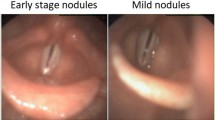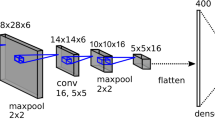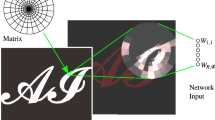Abstract
In this work, a three dimensional (3D) convolutional neural network (CNN) model based on image slices of various normal and pathological vocal folds is proposed for accurate and efficient prediction of glottal flows. The 3D CNN model is composed of the feature extraction block and regression block. The feature extraction block is capable of learning low dimensional features from the high dimensional image data of the glottal shape, and the regression block is employed to flatten the output from the feature extraction block and obtain the desired glottal flow data. The input image data is the condensed set of 2D image slices captured in the axial plane of the 3D vocal folds, where these glottal shapes are synthesized based on the equations of normal vibration modes. The output flow data is the corresponding flow rate, averaged glottal pressure and nodal pressure distributions over the glottal surface. The 3D CNN model is built to establish the mapping between the input image data and output flow data. The ground-truth flow variables of each glottal shape in the training and test datasets are obtained by a high-fidelity sharp-interface immersed-boundary solver. The proposed model is trained to predict the concerned flow variables for glottal shapes in the test set. The present 3D CNN model is more efficient than traditional Computational Fluid Dynamics (CFD) models while the accuracy can still be retained, and more powerful than previous data-driven prediction models because more details of the glottal flow can be provided. The prediction performance of the trained 3D CNN model in accuracy and efficiency indicates that this model could be promising for future clinical applications.












Similar content being viewed by others
Data Availability Statement
The data that supports the findings of this study are available from the corresponding author upon reasonable request.
References
Cho, W. K., & Choi, S. H. (2022). Comparison of convolutional neural network models for determination of vocal fold normality in laryngoscopic images. Journal of Voice, 36(5), 590–598.
Smith, S. L., & Titze, I. R. (2018). Vocal fold contact patterns based on normal modes of vibration. Journal of Biomechanics, 73, 177–184.
Aziz, M., Dillman, D., Fu, R., & Brambrink, A. (2012). Comparative effectiveness of the C-MAC video laryngoscope versus direct laryngoscopy in the setting of the predicted difficult airway. Anesthesiology, 116(3), 629–636.
Niforopoulou, P., Pantazopoulos, I., Demestiha, T. D., Koudouna, E., & Xanthos, T. T. (2010). Video-laryngoscopes in the adult airway management: a topical review of the literature. Acta Anaesthesiologica Scandinavica, 54(9), 1050–1061.
Wu, Z., Xuan, S., Xie, J., Lin, C., & Lu, C. (2022). How to ensure the confidentiality of electronic medical records on the cloud: A technical perspective. Computers in Biology and Medicine, 147, 105726.
Beinecke, J. M., Anders, P., Schurrat, T., Heider, D., Luster, M., Librizzi, D., & Hauschild, A.-C. (2022). Evaluation of machine learning strategies for imaging confirmed prostate cancer recurrence prediction on electronic health records. Computers in Biology and Medicine, 143, 105263.
Hu, K., Zhao, L., Feng, S., Zhang, S., Zhou, Q., Gao, X., & Guo, Y. (2022). Colorectal polyp region extraction using saliency detection network with neutrosophic enhancement. Computers in Biology and Medicine, 147, 105760.
Hossain, E., Rana, R., Higgins, N., Soar, J., Barua, P., Pisani, A., & Turner, K. (2023). Natural language processing in electronic health records in relation to healthcare decision-making: A systematic review. Computers in Biology and Medicine, 155, 106649–106649.
Luo, H., Mittal, R., Zheng, X., Bielamowicz, S. A., Walsh, R. J., & Hahn, J. K. (2008). An immersed-boundary method for flow structure interaction in biological systems with application to phonation. Journal of Computational Physics, 227(22), 9303–9332.
Zheng, X., Xue, Q., Mittal, R., & Beilamowicz, S. (2010). A coupled sharp-interface immersed boundary-finite-element method for flow-structure interaction with application to human phonation. Journal of Biomechanical Engineering, 132(11), 111003.
Mittal, R., Zheng, X., Bhardwaj, R., Seo, J., Xue, Q., & Bielamowicz, S. (2011). Toward a simulation-based tool for the treatment of vocal fold paralysis. Frontiers in Physiology, 2, 19.
Xue, Q., Zheng, X., Mittal, R., & Bielamowicz, S. (2014). Subject-specific computational modeling of human phonation. The Journal of the Acoustical Society of America, 135(3), 1445–1456.
Jiang, W., Zheng, X., & Xue, Q. (2017). Computational modeling of fluid–structure–acoustics interaction during voice production. Frontiers in Bioengineering and Biotechnology, 5, 7.
Gómez, P., Schützenberger, A., Semmler, M., & Döllinger, M. (2018). Laryngeal pressure estimation with a recurrent neural network. IEEE Journal of Translational Engineering in Health and Medicine, 7, 1–11.
Zhang, Z. (2020). Estimation of vocal fold physiology from voice acoustics using machine learning. The Journal of the Acoustical Society of America, 147(3), 264–270.
Li, Z., Chen, Y., Chang, S., Rousseau, B., & Luo, H. (2021). A one-dimensional flow model enhanced by machine learning for simulation of vocal fold vibration. The Journal of the Acoustical Society of America, 149(3), 1712–1723.
Zhang, Y., Jiang, W., Sun, L., Wang, J., Zheng, X., & Xue, Q. (2022). A deep learning-based generalized empirical flow model of glottal flow during normal phonation. Journal of Biomechanical Engineering, 144(9), 091001.
Matava, C. T., Pankiv, E., Raisbeck, S., Caldeira, M., & Alam, F. (2020). A convolutional neural network for real time classification, identification, and labelling of vocal cord and tracheal using laryngoscopy and bronchoscopy video. Journal of Medical Systems, 44, 1–10.
Kist, A. M., Zilker, J., Gómez, P., Schützenberger, A., & Döllinger, M. (2020). Rethinking glottal midline detection. Scientific Reports, 10(1), 1–15.
Laves, M.-H., Bicker, J., Kahrs, L. A., & Ortmaier, T. (2018). A dataset of laryngeal endoscopic images with comparative study on convolution neural network-based semantic segmentation. International Journal of Computer Assisted Radiology and Surgery, 14, 483–492.
Yao, P., Witte, D., Gimonet, H., German, A., Andreadis, K., Cheng, M., Sulica, L., Elemento, O., Barnes, J., & Rameau, A. (2022). Automatic classification of informative laryngoscopic images using deep learning. Laryngoscope Investigative Otolaryngology, 7(2), 460–466.
Wang, J., Xu, X., Ma, Y., Zhuang, P., & Wang, Y. (2022). Application of 4D-CT scanning in differential diagnosis of arytenoid subluxation and vocal fold paralysis. Journal of Voice, 36(6), 859–867.
Story, B. H., Titze, I. R., & Hoffman, E. A. (1998). Vocal tract area functions for an adult female speaker based on volumetric imaging. The Journal of the Acoustical Society of America, 104(1), 471–487.
Zunair, H., Rahman, A., Mohammed, N., & Cohen, J. P. (2020). Uniformizing techniques to process CT scans with 3D CNNs for tuberculosis prediction. PRIME 2020: International workshop on PRedictive Intelligence In MEdicine, Lima, Peru (pp. 156–168).
Maturana, D., & Scherer, S. (2015). Voxnet: A 3D convolutional neural network for real-time object recognition. In 2015 IEEE/RSJ international conference on intelligent robots and systems (IROS), Hamburg, Germany (pp. 922–928).
Zhang, Y., Zheng, X., & Xue, Q. (2020). A deep neural network based glottal flow model for predicting fluid–structure interactions during voice production. Applied Sciences, 10(2), 705.
Mittal, R., Dong, H., Bozkurttas, M., Najjar, F., Vargas, A., & Von Loebbecke, A. (2008). A versatile sharp interface immersed boundary method for incompressible flows with complex boundaries. Journal of Computational Physics, 227(10), 4825–4852.
Indolia, S., Goswami, A. K., Mishra, S. P., & Asopa, P. (2018). Conceptual understanding of convolutional neural network—A deep learning approach. Procedia Computer Science, 132, 679–688.
Kingma, D. P., & Ba, J. (2014). Adam: A method for stochastic optimization. arXiv preprint arXiv:1412.6980
Jin, X., Cheng, P., Chen, W.-L., & Li, H. (2018). Prediction model of velocity field around circular cylinder over various Reynolds numbers by fusion convolutional neural networks based on pressure on the cylinder. Physics of Fluids, 30(4), 047105.
Peng, J.-Z., Chen, S., Aubry, N., Chen, Z.-H., & Wu, W.-T. (2020). Time-variant prediction of flow over an airfoil using deep neural network. Physics of Fluids, 32(12), 123602.
Acknowledgements
This work is supported by the Open Project of Key Laboratory of Computational Aerodynamics, AVIC Aerodynamics Research Institute (Grant No. YL2022XFX0409).
Author information
Authors and Affiliations
Corresponding author
Ethics declarations
Conflict of interest
On behalf of all authors, the corresponding author states that there is no conflict of interest.
Additional information
Publisher's Note
Springer Nature remains neutral with regard to jurisdictional claims in published maps and institutional affiliations.
Rights and permissions
Springer Nature or its licensor (e.g. a society or other partner) holds exclusive rights to this article under a publishing agreement with the author(s) or other rightsholder(s); author self-archiving of the accepted manuscript version of this article is solely governed by the terms of such publishing agreement and applicable law.
About this article
Cite this article
Zhang, Y., Pu, T., Xu, J. et al. Image-Based Flow Prediction of Vocal Folds Using 3D Convolutional Neural Networks. J Bionic Eng 21, 991–1002 (2024). https://doi.org/10.1007/s42235-023-00466-3
Received:
Revised:
Accepted:
Published:
Issue Date:
DOI: https://doi.org/10.1007/s42235-023-00466-3




